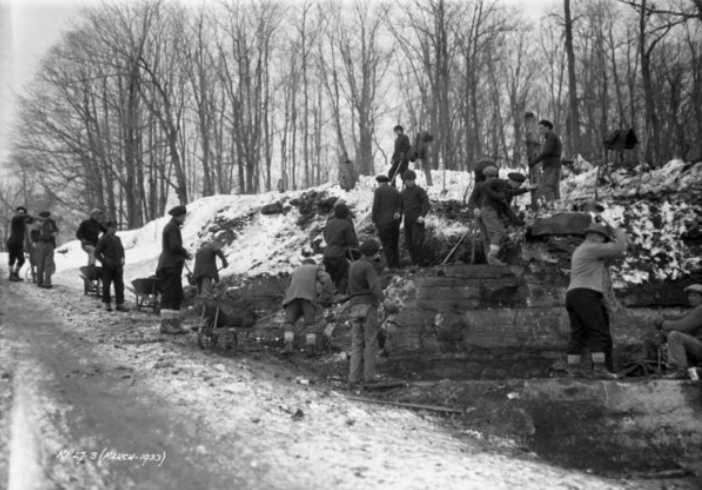Remember This? Rockcliffe relief camp
Posted Jul 12, 2021 01:00:00 PM.
CityNews, in partnership with the Historical Society of Ottawa, brings you this weekly feature by Director James Powell, highlighting a moment in the Ottawa's history.
July 10, 1935
It was the Dirty Thirties. Across the country, factory after factory were falling idle as the Great Depression deepened. In the countryside, low agricultural prices combined with persistent drought in the Prairies spelt ruin for thousands of farmers. The rate of unemployment rose to levels never seen before.
To make matters worse, there was not much of a government safety net for those affected. There was no unemployment insurance, little in the way of welfare, and no government-provided health care. The situation for young, single men was especially dire. They were not part of the “deserving poor,” and were expected to fend for themselves. But how could they when there were no jobs to be had anywhere? At risk of being thrown into jail for vagrancy if found loitering on street corners, thousands took to the roads or rails, going from town to town in search of casual labour, a bowl of soup and a place to doss down for the night. These were hard times.
In 1930, the Conservatives, under R.B. Bennett were elected to do something about the growing unemployment problem, but conditions only deteriorated. Authorities feared that young, idle men would become radicalized by communist propaganda. The Communist Party of Canada was banned in 1931, its leaders arrested. But this did little to stop left-wing agitation for change.
Worried about the growing ranks of unemployed young men, many of whom had never held a steady job, General Andrew McNaughton, Chief of the Canadian General Staff, came up with the idea of establishing temporary relief camps across the country for the estimated 70,000 single, unemployed, homeless, and malnourished men that were tramping the roads. In these camps, such men would receive food, shelter, clothing, medical care, a 20-cent per day gratuity and, most importantly, would regain their self-esteem. In exchange, they would work on worthwhile government infrastructure projects.
The federal government seized the idea and launched a relief camp program via an Order-in-Council on October 8, 1932.
By the following month, thousands of men had signed up. In total, 144 relief camps were established across Canada, of which 57 were in British Columbia and 37 in Ontario. Most of the camps were located in relatively remote locations with the men working to improve a cross-Canada system of aerodromes and landing strips in support of the nascent Trans-Canada Airways, the forerunner of Air Canada. Other projects included road-building and tree-planting. The government also hoped that if the camps were located far from urban centres, the young men inside them would be less exposed to radical views.
While most projects were located far away from urban areas, there were exceptions. Relief camps were established in Trenton and, most importantly for this story, in Rockcliffe, just outside of Ottawa, to improve aerodrome facilities and runways.
The Rockcliffe relief camp took in its first residents at the end of October, 1932, when 30 men at the Employment Service Bureau in Ottawa signed on. They were immediately taken to Rockcliffe where they were fed, and provided with serviceable clothes. Work began the next morning with the residents constructing huts to accommodate the expected influx of men to follow in the coming months.

Initially, the general sentiment toward the relief camp program was favourable. Newspaper editorials were positive.
In November 1932, the head foreman at the Ottawa Relief Unit, Rockcliffe wrote a letter to the editor of the Ottawa Citizen saying that on behalf of the unit he expressed his appreciation for the comfort and entertainment provided in their off-hours as well as the thoughtfulness of Wing Commander Godfrey, the commanding officer of the air base and relief camp, for providing entertainment, including games and cards. He also thanked Mrs. Godfrey who had supplied 150 books and magazines. He added that members of the Ottawa Air Station had been co-operative and courteous, and that the base chef had provided culinary tips to the camp’s cook so that he could serve the best possible meals with their food rations.
From time to time, musical entertainment and vaudeville shows were put on for camp residents by RCAF personnel stationed at the camp and outside groups such as the Salvation Army. Athletic contests were also held to keep men occupied during their off hours.
Many believed that that Rockcliffe camp was among the best. This was likely true due to its proximity to Ottawa and hence the destination of VIPs wishing to see what a relief camp was like.
In January 1933, the Governor General, the Earl of Bessborough, toured the camp. He was accompanied by the Minister of Labour and General McNaughton himself. The distinguished visitors were received by Wing Commander Godfrey. A week later, another official visit occurred. On this occasion, one of the guests was future Ottawa mayor Charlotte Whitton. At the time, Whitton was a well-known child and family advocate as well as a staunch supporter of relief camps as a means of dealing with high unemployment.
Frontier College, which had been established in 1899 to provide education in northern lumber camps, eventually provided education to residents in the Rockcliffe relief camp. But resources were very limited. An instructor sent out an appeal for well-liked magazines such as Popular Mechanics, Popular Science, Popular Aviation, National Geographic, and Weekly News Illustrated. He also requested donations of popular fiction by such modern authors as Zane Grey, D.H. Lawrence and J.B. Priestly.
By 1935, there was more than 500 men residing in the Rockcliffe relief camp.
In addition to building a number of frame accommodation buildings, they cleared and levelled the aerodrome’s landing field, erected a three-storey building to house the RCAF photographic section, and constructed sewers and water mains.
Despite broad public support at the launch of the relief camp program, signs of discontent quickly emerged.
In August 1933, the Workers’ Ex-Servicemen’s League held a meeting in Ottawa protesting the “military slave camps” at Rockcliffe and elsewhere. The following year, a Rockcliffe camp resident praised the self-discipline and courtesy of the men but had little good to say about the accommodations or the food. He said that there were 50 men in a house intended for a single family. However, despite the close quarters, the house was kept orderly and clean. Nights were quiet from lights out at 10 p.m. until wake up at 6:30 a.m. While the “No talking signs” in the dining room were generally ignored, table manners were good, and were “far above the quality of the repasts.”
Camp administrators kept close tabs on the men. When a camp resident left without permission in 1934, he was tracked down and arrested by the RCMP, and charged with theft of government property—the clothes on his back. Marked with a “broad arrow with the letter ‘C’”, the second-hand clothes were said to have had an unlikely value of $12.65. The poor man was jailed.
In June 1935, things became tense at the Rockcliffe camp.
Workers in relief camps in British Columbia, organized in part by communist party members, had begun their famous trek to Ottawa to present their demands to the Bennett government. The most important of their demands was fair pay for the work they did. They wanted 50 cents per hour for unskilled labour, and union rates for skilled workers.
The RCMP reported that a bulletin had been circulated amongst trekkers that camp workers from Rockcliffe were preparing to meet them when they reached Ottawa. At the Rockcliffe camp, captains and lieutenants were secretly elected in each hut to represent the men.
The B.C. strikers’ trek to Ottawa was suppressed in Regina on Dominion Day, 1935, by the RCMP and railway police on the orders of the federal government with the loss of two lives and many injured.
However, the Rockcliffe men were not deterred. On July 8, 1935, they went on strike for better pay and living conditions. Their demands were more modest than those of the B.C. strikers. The Rockcliffe men demanded $1 per day for an eight-hour work day. Other demands included: a better variety of food; sleeping quarters in accordance with provincial health requirements; the replacement of the military administration of the camp by the Department of Labour; and an immediate and impartial investigation of the conditions in the camp by the Department of Labour.
Strike leaders said that all 500 camp residents had joined the strike which began at 8 a.m., after breakfast. Wing Commander Godfrey disagreed with this count, claiming that an official check at meal-time showed that not more than 150 had answered the strike call.
A dozen strike leaders, including their principal spokesman, J.S. Downham, were expelled from the camp on orders of the Department of National Defence. Two detachments of RCMP officers and the entire RCAF force of officers and men stationed at the Rockcliffe Air Station were there to enforce the order. The policemen were armed with their service revolvers and “riot” sticks. Some of the RCMP officers were on horseback.
For a few minutes, it was a tense standoff, but the situation eased when the strike leaders agreed to go peacefully. As the leaders were led away, the surrounding strikers jeered and mocked the police. Men shouted out to their leaders, “We’re behind you all the way” and “We’re not through yet.” The twelve went back to their huts to pack their belongings. They were then given their evening meals, paid their allowances, and driven to Ottawa.
Reporters rushed out to the camp from Ottawa to interview the strikers who aired their grievances. The major complaint was pay. Men resented working alongside bricklayers and carpenters hired from Ottawa, who were earning $1.10 per hour and $0.70 per hour, respectively, far more than the camp workers. “We must eliminate slave camps,” said one striker. Another said that he “wanted to earn enough to get a stake to seek an outside job.”
Wing Commander Godfrey said he was acting upon orders from the Department of Defence. He also noted that the men had struck without putting in any official complaint to him and until that point they had been satisfied with camp conditions. He claimed that most men realized that the camps were just a means to keep them fed, housed and occupied until they could get jobs outside.
Despite the ejection of the leaders, the strike went on. After lunch the following day, a strike bulletin was posted on the door of the dining room telling strikers not to go to work until further notice. “Show your spirit in this fight,” it added.
The situation came to a head on July 10, 1935.
At 7:30 a.m., all 508 men in the camp were ordered onto the athletic field. Many remained in their huts. On the opposite side of the field were 36 mounted RCMP officers who put on an intimidating show of force.
Wing Commander Godfrey gave the men an ultimatum from headquarters: “Work or Get Out!”
While he said he was powerless to address the pay issue as this was government policy, he could tackle some of the other complaints. Regarding meals, he said there had been cases where the contractor had supplied meat unfit for human consumption. It had been returned. However, he would immediately look into the quality issue. He also promised that the huts would be re-organized to give each man “increased air space.”
He then asked all those willing to work to stay on the field and demanded that those who chose not to work to leave the camp immediately, or be forcibly ejected. As strike diehards walked off the field, they jeered at those who remained, calling them “scabs” or worse. Meanwhile, camp administrators and police conducted a hut-by-hut search of men who had not appeared at the parade. These men were given the same choice—work or get out.
In the end, 138 men were ejected from the Rockcliffe relief camp. They were taken by truck to downtown Ottawa where they were dropped off, most at the corner of Rideau Street and Charlotte Street. They had little beyond the clothes on the backs and their meagre allowance. Some assembled at 11 a.m. in Cartier Square and then walked to Plouffe Park at the corner of Preston and Somerset Streets when they had heard that arrangements for foot and shelter would be found there.
The men dispersed peacefully. Some found temporary shelter and food at the Union Mission. Others went to stay with relatives, or dossed down in parks or in train boxcars. Mayor Nolan told the men to find work or leave town; the city would not support them. He advised them to return to the camp as they were the federal government’s responsibility.
Some took the mayor’s advice and asked to be reinstated. Most did not. What happened to them was not recorded. For the more than 350 men who remained, life returned to what it had been. With so many men evicted, their accommodations became more comfortable.
In October 1935, the Bennett government was trounced in the general election over its handling of the Great Depression. The Liberals under Mackenzie King returned to power. Among their promises was a commitment to close the relief camps.
As a first step, in April 1936 the men were given wages of $15 per month, instead of the daily 20-cent gratuity. By June, the camps were closed. Some 10,000 camp workers, including most of the Rockcliffe workers, found government-subsidized maintenance jobs with the railways. But for the rest, regular employment was not found until the outbreak of war in 1939.








